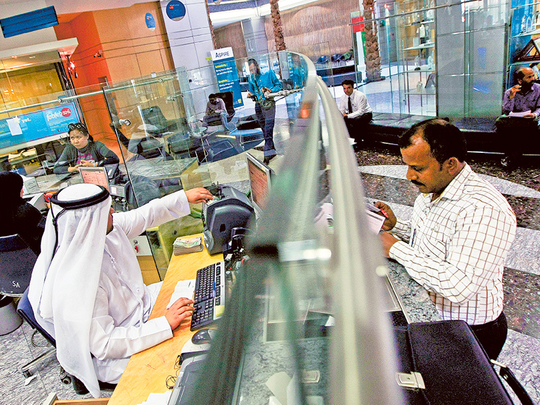
Dubai: The UAE Central Bank’s decision to support the UAE banking system through an extraordinary Dh100 billion stimulus package is expected to support the liquidity and solvency of UAE banks — at a time the coronavirus outbreak and the impact from oil price collapse is expected to adversely impact both deposits and loan growth.
The central bank support will be split into Dh50 billion from the Central Bank’s own funds, which will be offered to local banks at zero interest rates.
These will be routed as collateralised loans to the borrowing banks. An additional Dh50 billion will be tapped through the capital buffers operated by banks operating in the country.

UAE Central Bank’s decision to proactively provide an Dh100 billion stimulus package will give a significant boost to the UAE banking sector, and have far-reaching impact on various sectors that underpin the economy. During these times of worldwide uncertainty, taking decisive measures like this one is key to ensuring a safe and stable environment, so we commend the UAE’s leadership for their quick efforts to protect businesses and safeguard the wellbeing of citizens.
The UAE Central Bank and the federal government have always stepped in to support the country’s banking system when there are signs of crisis on the horizon.
“UAE Central Bank’s decision to proactively provide an Dh100 billion stimulus package will give a significant boost to the UAE banking sector, and have far-reaching impact on various sectors that underpin the economy. During these times of worldwide uncertainty, taking decisive measures like this one is key to ensuring a safe and stable environment, so we commend the UAE’s leadership for their quick efforts to protect businesses and safeguard the wellbeing of citizens,” said AbdulAziz Al Ghurair, Chairman of UAE Banks Federation.
Support
It's not the first time the UAE' central monetary authority is taking such action.
In 2008, the UAE banks landed in a serious liquidity squeeze after foreign banks withdrew Dh100 billion worth of funds from the local banks following the financial crisis amid heighted speculation of rising loan impairment and potential depegging of the dirham.
The Central Bank of the UAE and the Ministry of Finance in total made available Dh120 billion to the local banks to provide the much-needed liquidity boost.
In October 2008, the finance ministry poured Dh25 billion into bank deposits to boost liquidity at banks, the first tranche of the Dh70 billion rescue facility. It deposited another Dh25 billion into banks in November the same year.
Given adequate support, the UAE banks recovered their mojo within months.
Over time, the country’s banks have become flush with depositors’ cash once again as the country’s political stability and sustainable economic growth embellish its safe haven appeal to regional and global investors.
Pre-empting a crisis
The CBUAE has once again used its financial strength to support the banking system and the economy before the coronavirus outbreak — and a potentially prolonged low oil prices — impacted the liquidity, solvency and profitability of banks while supporting the UAE economy through making funds available to private sector.
How will this move help businesses?
By using the central bank support, banks can continue to lend and offer relief to businesses that will be impacted by the virus outbreak and oil price decline.
Leading global credit rating agencies had warned last week that a prolonged period of oil price volatility and the impact of coronavirus (COVID-19) on the regional economies will impact the solvency, liquidity profitability of banks across GCC countries.
“Oil prices, public spending and the credit quality of GCC banks are significantly interlinked and all six GCC countries depend heavily on oil and gas revenues,” said Nitish Bhojnagarwala, vice president and senior credit officer at Moody’s.
What's the impact on assets and liabilities?
The immediate effect of a sustained period of lower oil prices would be on the liability side, particularly reduced deposit inflows from government and government-related entities.
“We estimate that government deposits range between 15 per cent and 34 per cent of the deposits of the GCC banking systems,” said Bhojnagarwala.
Rating agency Standard & Poor’s (S&P) said combination of factors such as lower oil prices, economic impact of coronavirus on regional economies and a deterioration in asset quality could weaken bank profitability in the region.
“The knock-on effects of lower economic growth and oil prices will further slow lending growth and increase the overall stock of problem assets at GCC banks. As a result, we anticipate that cost of risk will edge up. At the same time, interest margins will decline because the US Federal Reserve Board and other local central banks have cut interest rates. Combined, these shifts will weaken banks’ profitability,” said Mohamed Damak, Director of Research at S&P.
What does the CB-UAE's move show?
The CBUAE has both the ability and willingness to support its banking system from any potential systemic risks.
For the central bank — which has Dh405 billion in foreign currency reserves — and a government that sits on strong external balances supporting its banking system in a difficult environment, this move is relatively easier compared to many global peers.
Analysts said banks in Saudi Arabia and the UAE are facing some existing pressures. But are likely to be moderately affected specifically as a result of the decline in oil prices because of the countries’ relatively large reserve buffers.
Both governments can in principle sustain public spending to support economic growth.
Easier lending norms
The Dh100 billion stimulum will allow banks to offer temporary relief (of up to six months) for businesses and individuals who may be struggling to principal and/ or interest payments on their loans. In addition, banks now can boost lending to small and medium enterprises (SMES), with lower capital buffers required by the central bank for these loans.
The package allows an increas of maximum loan-to-value (LTV) of mortgages for first time buyers to 80 per cent from 75 per cent previously, and banks have a higher ceiling on their maximum exposure to real-estate at 30 per cent from 20 per cent.
“The Loan-To-Value (LTV) increase of 5% for first-time buyers brought by the initiative is welcomed. This is something that has been long mooted, even before the Covid-19 outbreak, and it now gives buyers who are saving for a deposit a helping hand to make their first UAE property purchase,” said Lewis Allsopp, CEO of Allsopp & Allsopp, a real estate brokerage.
Banks operating in the UAE remain well capitalized, with the Capital Adequacy Ratio (CAR) at 17.6 per cent, Tier 1 Capital Ratio at 16.4 per cent, and Common Equity Tier 1 Ratio (CET 1) at 14.6 per cent, which are well above the regulatory requirements set by the CBUAE.
The loans to deposits (L/D) ratio for the whole banking system decreased from 95.5 per cent in September 2019 to 94.1 per cent at the end of December 2019, mainly due to the higher growth rate of deposits compared to the registered growth in gross credit, the central bank said in report at the year end 2019.
Meanwhile, the eligible liquid assets,11 as a ratio of total liabilities, increased to reach 18.2 per cent at the year end of 2019 . This level of liquid assets constitutes an adequate liquidity buffer—above the 10 per cent regulatory minimum required by the CBUAE. The level of total liquid assets at banks, as of the end of 2019, stood at Dh455.9 billion.
On a year on year basis, total liquid assets at banks rose by Dh48.3 billion—an increase by 11.8 per cent in 2019 compared to 2018.
Looking at the breakdown between the banks, the end-of-year data show that the increase in ELAR was broad based and increased for both Islamic and national banks as well as for conventional and foreign banks.








